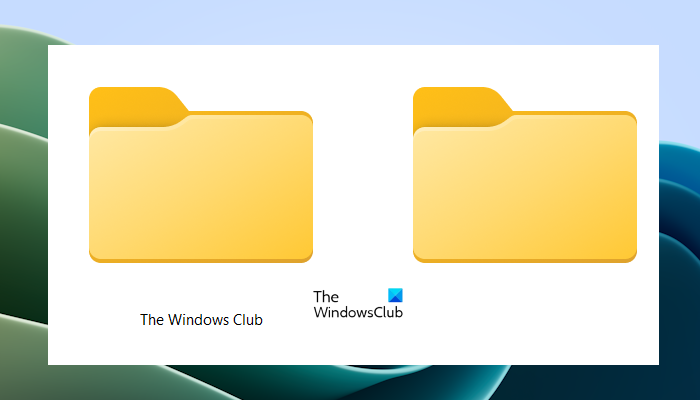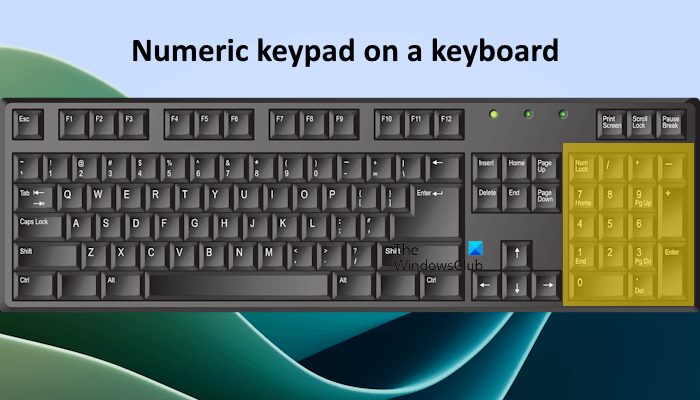Do you know that in Windows 11/10, you can create folders without any name? Usually, when you create a folder on a Windows computer, Windows gives it a default name, New folder. You can change this default name to any custom name later. However, by using the trick we will explain in this article, you will be able to create blank folder names in Windows 11/10.

Create blank folder names in Windows 11/10
Let’s see how to create blank folder names in Windows 11/10. Using this trick, you can display a folder without a name. However, your computer needs to have a Numeric keyboard pad. In case some of you do not know, the Numeric keypad or NumPad is the section of the keyboard on the right side, which usually contains 17 keys, viz. 0 to 9, +, -, *, /, ., Num Lock and Enter keys.

To create blank folder names in Windows 11/10, right-click on the Windows desktop or in the directory where you want to create a new folder. Now, select New > Folder. A new folder will be created. If you right-click the folder, select Rename, and enter only spaces, the operating system will not accept it. In this case, Windows does not change its name and you will get the previous name after hitting Enter.
To remove the name and display a blank name, right-click on the folder and select Rename. Now press and hold the Alt key and then, from the Numeric keypad, press 0160. After typing this code from the Numeric keypad, release the Alt key. When you release the ALt key, you will see that the name of the folder has disappeared. Now press Enter.
A folder with no name will be created. The same folder with no name can also be created with the code 255. Press and hold the Alt key and then type 255 from your Numeric keypad, and then hit Enter.
Do note that to do this trick, you need to use only the left Alt key. If you use the right Alt key, this trick will not work.
![]()
You can make this folder with no name a smart-looking folder by changing its icon. To do so, right-click on it and open its Properties. Now, go to the Customize tab and click on the Change icon button. Select any icon from the popup window that appears and click OK. Now, click Apply and then click OK.
![]()
Look at the above image. I changed its default folder icon to a computer monitor. Looks pretty cool!
Read: How to create a file without an Extension in Windows.
How to make blank folder names on laptops with no Numpad?
You need to enable the Num Pad on a laptop.
To enable Numpad you should be able to click the Shift+Num Lock keys to enable/disable it. This allows you to use numbers for the letter keys. Some use the ‘FN+Num lk’ key combo to enable/disable. You’ll find that the Numpad keys are shared with the numbers 7, 8, 9, and the letters U, I, O, J, K, L, and M. If the Num Lock key is not present, this trick will not work.
Once you have enabled it, press “fn+num lk”, and then press MJOM keys to get 0160 numeric to get a name-less folder on your laptop!
You can also create a folder without any icon or name in Windows.
How do you create a new folder name?
When you create a new folder, Windows gives it the name New folder. If you keep creating new folders in the same directory, Windows gives them a name: New folder (2), New folder (3), and so on. You can rename the folders created on your system. To do so, right-click on the folder, the name of which you want to change, and then select Rename. Alternatively, you can also press the F2 key to rename a folder. Laptop users may have to press the Fn + F2 keys to rename a folder.
How to create a secret folder in Windows?
A secret folder is a folder that remains hidden from other users on a Windows PC. You can create a secret folder on your system by changing its Attributes. To do so, first, create a folder on your system, then right-click on it and select Properties. Under the General tab, select the Hidden checkbox. Click Apply and then click OK. From now on, this folder will remain hidden from all other users. However, if any user knows how to display hidden files and folders, he can access the secret hidden folder.
Now read:
I am sure you will like these posts, too.